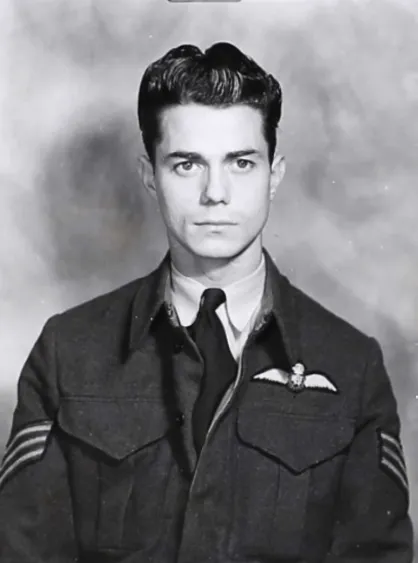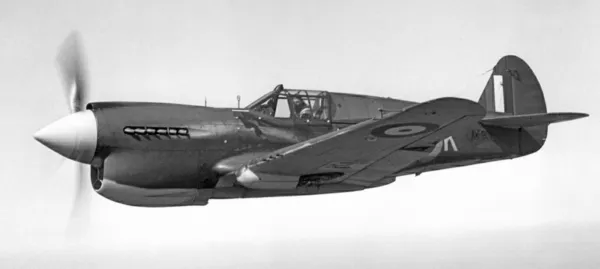Bell, Raymond Melvin (Flying Officer)
Killed in Flying Accident 1943-August-14


Birth Date: 1918-August-07
Born:
Parents:
Spouse:
Home: Hot Springs, Arkansas, USA
Enlistment:
Enlistment Date: unkown date
Service
RCAF
Unit
14 Sqn- Squadron (RAF)
I Spread My Wings And Keep My Promise
Base
RAF Protville, Tunisia
Rank
Flying Officer
Position
Pilot
Service Numbers
J/27371
Crew or Other Personnel
Kittyhawk 1099
Kittyhawk serial: 1099

Curtiss P-40 Kittyhawk from No. 118 (Fighter) Squadron, RCAF, located in Dartmouth, Nova Scotia, photographed on 4 April 1942.
The Curtiss P-40 (known as the Warhawk in the USA) is single-engined, single-seat, all-metal fighter and and ground-attack aircraft that first flew in 1938. The British Commonwealth air forces including the RCAF, and the Soviet air forces used the name Tomahawk for models equivalent to the P-40B and P-40C, and the name Kittyhawk for models equivalent to the P-40D and all later variants. The P-40 was in frontline service until the end of the Second World War. It was the third most-produced American fighter of the war after the P-51 and P-47, with 13,738 being built in Buffalo, New York. Based on war-time victory claims, over 200 Allied fighter pilots from 7 different nations (Australia, Canada, England, New Zealand, South Africa, the Soviet Union and the United States) became aces flying the P-40. A total of 13 RCAF units operated the Kittyhawk in the North West European or Alaskan theaters.
In mid-May 1940, Canadian and US officers watched comparative tests of a XP-40 and a Spitfire, at RCAF Station Uplands, Ottawa, Ontario. While the Spitfire was considered to have performed better, it was not available for use in Canada and the P-40 was ordered to meet home air defense requirements. In all, eight Home War Establishment Squadrons were equipped with the Kittyhawk: 72 Kittyhawk Mk. I, 12 Kittyhawk Mk. Ia, 15 Kittyhawk Mk. III and 35 Kittyhawk Mk. IV aircraft, for a total of 134 aircraft. These aircraft were mostly diverted from RAF Lend-Lease orders for service in Canada. The Kittyhawks were obtained in lieu of 144 Bell P-39 Airacobras originally allocated to Canada but reassigned to the RAF.
However, before any home units received the Kittyhawk, three RCAF Article XV squadrons operated Tomahawk aircraft from bases in the United Kingdom. No. 403 Squadron RCAF, a fighter unit, used the Tomahawk Mk. II briefly before converting to Spitfires. Two Army Co-operation (close air support) units, No. 400 Squadron and No. 414 Squadron, trained with Tomahawks, before converting to Mustang Mk. I aircraft and taking on a fighter/reconnaissance role. Of these, only No. 400 Squadron used Tomahawks operationally, conducting a number of armed sweeps over France in the late 1941. RCAF pilots also flew Tomahawks or Kittyhawks with other British Commonwealth units based in North Africa, the Mediterranean, South East Asia and (in at least one case) the South West Pacific.
In 1942, the Imperial Japanese Navy occupied two islands, Attu and Kiska, in the Aleutians off Alaska. RCAF home defense Kittyhawk squadrons saw combat over the Aleutians, assisting the USAAF. The RCAF initially sent No. 111 Squadron, flying the Kittyhawk Mk. I, to the US base on Adak island. During the drawn-out campaign, 12 Canadian Kittyhawks operated on a rotational basis from a new, more advanced base on Amchitka,75 miles (121 km) southeast of Kiska. No. 14 and No. 111 Sqns took "turn-about" at the base. During a major attack on Japanese positions at Kiska on 25 September 1942, Squadron Leader Ken Boomer shot down a Nakajima A6M2-N Rufe seaplane. The RCAF also purchased 12 P-40Ks directly from the USAAF while in the Aleutians. After the Japanese threat diminished, these two RCAF squadrons returned to Canada and eventually transferred to England without their Kittyhawks.
In January 1943, a further Article XV unit, No. 430 Squadron was formed at RAF Hartford Bridge, England and the pilots trained on the obsolete Tomahawk Mk. IIA. The squadron converted to the the Mustang Mk. I before commencing operations in mid-1943.
In early 1945 pilots from No. 133 Squadron RCAF, operating Kittyhawks out of RCAF Station Patricia Bay, Victoria, British Columbia, intercepted and destroyed two Japanese balloon-bombs, which were designed to cause wildfires on the North American mainland. On 21 February, Pilot Officer E. E. Maxwell shot down a balloon, which landed on Sumas Mountain in Washington State. On 10 March, Pilot Officer J. 0. Patten destroyed a balloon near Saltspring Island, BC. The last interception took place on 20 April 1945 when Pilot Officer P.V. Brodeur from No. 135 Squadron out of Abbotsford, BC, shot down a balloon over Vedder Mountain. Harold Skaarup web page and Wikipedia
Aircraft Images
Kittyhawk 1099
Kittyhawk I 1099
Diverted from RAF order placed in May 1940, serial AL228. Equivalent to USAAF P-40D. Operated by Test & Development Establishment at RCAF Station Rockcliffe, Ontario, still with RAF serial. Category C2 damage on 12 July 1942, while serving with No. 14 (F) Squadron on West Coast.1942-01-13 Taken on Strength 2019-08-20
1943-August-14 Accident: 14 Squadron Loc: Bering Sea Names: Bell
1943-12-23 Struck off Strength 2019-08-20